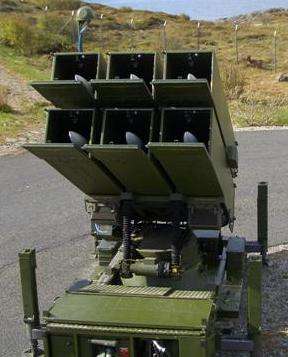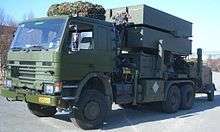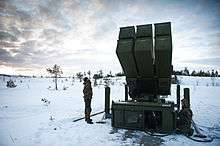NASAMS
| Norwegian Advanced Surface to Air Missile System | |
|---|---|
 NASAMS launcher | |
| Type | Surface-to-air missile system |
| Place of origin | Norway/United States |
| Service history | |
| In service | 1998–present |
| Used by | See operators |
| Production history | |
| Designer | Kongsberg Defence & Aerospace and Raytheon |
| Manufacturer | Kongsberg Defence & Aerospace |
NASAMS (Norwegian Advanced Surface to Air Missile System) is a distributed and networked medium to long range air-defence system. NASAMS was the first surface-based application for the AIM-120 AMRAAM (Advanced Medium Range Air-to-Air Missile). The missile itself is named SLAMRAAM (Surfaced Launched AMRAAM).[1]
NASAMS 2 is an upgraded version of the NASAMS air-defence system and it has been operational since 2007.
Development
The Norwegian company Kongsberg Defence & Aerospace teamed up with Raytheon and initiated the NASAMS programme as a cooperative effort for the Royal Norwegian Air Force. The network-centric air defence system NASAMS was declared fully operational capable in 1998 but had an initial operational capability as early as in 1994/95.
Until the late 1990s the RNoAF ground-based air defence solution, also known as the Norwegian Solution (NORSOL), consisted of three different weapon systems; the 40mm Bofors L70 gun (controlled by the Oerlikon Contraves FCS2000 monopulse doppler tracking radar), the laser beam riding RBS 70 MANPADS system and the NASAMS. All three systems were integrated through the ARCS via field wires and radio. The ARCS maintained connection to higher echelons and ensured protection of friendly aircraft while preventing over- and underkill for all subordinate weapon systems. NASAMS capabilities[2] are enhanced by the system's networked and distributed nature.
NASAMS 2


The RNoAF together with KDA conducted a mid-life update of NASAMS, called NASAMS 2, and the upgraded version was first handed over to RNoAF in mid-2006. The major difference between the two versions is the use of Link 16 on NASAMS 2 as well as a better ground radar. Full operational capability (FOC) was expected for 2007.
A complete NASAMS (2) battery consists of 12 missile launchers (LCHR) (each one carrying six AIM-120 AMRAAM missiles), eight radars (AN/MPQ-64 Sentinel F1 Improved Sentinel X band 3D radar), one fire control centre (CTOC), one electro-optical camera vehicle (MSP500) and one Tactical Control Cell (TCC) vehicle.
The upgrades consist of:
- New radars, which can be mounted on a variety of vehicles. The radars have their own power supply and can process and distribute the data independently. The vehicles can be connected via radio links, cable, through Multi Rolle Radio, or through TADKOM.
- The radars have a broader frequency spectrum and variable rotation speeds, and also an increased capacity to spot and follow targets.
- Each module can automatically determine its position with its northfinder and GPS instruments.
- The control centre modules can be mounted on a large variety of vehicles
- The electro-optical MSP500 sensor is equipped with a laser rangefinder and a TV-camera, as well as an upgraded thermographic camera. These can be used to fire the missiles passively, which has been successfully tested.
The control system can detach itself from the sensors, in order to become less visible.
Description
The system integrates US-built MPQ-64 Sentinel air defense radar and AIM-120 AMRAAM missiles with an indigenously developed Battle management C4I system called FDC, short for Fire Distribution Center. The FDC connected to a MPQ-64 radar forms an "Acquisition Radar and Control System" (ARCS). The missile has a horizontal range of up to 25 km.[3] Other sources cite a range of 'over 15 km'[4] but this depends on the missile version used.
AMRAAM missile range:
• AIM-120A/B: 55–75 km
• AIM-120C-5: 105 km
• AIM-120C-7: 120 km
• AIM-120D: 180 km
Note that ranges for AAMs are estimated for head-on encounters for fast moving aircraft at an altitude, and the range is significantly shorter when the same missiles are launched from stationary ground platforms. Further dimensioning for a stationary ground-launched-missile system is its maximum altitude reach, which by rule of thumb is one third of its maximum horizontal range.
AMRAAM-ER

On 22 February 2015, Raytheon announced the development of the Extended Range upgrade to the NASAMS AMRAAM missile offering (AMRAAM-ER). Development work began in 2014, and the missile is actually an Evolved Sea Sparrow Missile using AMRAAM guidance. The first flight test took place in August 2016.[5] Production is expected by 2019.[6] Engagement envelope is expanded with a 50 percent increase in maximum range and 70 percent increase in maximum altitude;[7] range will extend to about 40 km.[8]
Service history
The NASAMS has been exported to the United States, with the NASAMS 2 upgrade having been exported to Finland, the Netherlands, Spain, Oman, and Chile.[9][10] Chile is though not mentioned as an official user, as Kongsberg stated: "NASAMS is in operational use in Norway, Spain, USA, the Netherlands, Finland, and one undisclosed customer, and in production for Oman."[11]
Several NASAMS were used to guard air space over Washington, D.C. during the 2005 United States presidential inauguration, and are used to protect air space around the White House.[12][13][14]
On 26 October 2017, Lithuania announced that it would be purchasing the NASAMS system to improve its own air defense capabilities.[15]
Operators







Potential future operators




See also
Notes
- ↑ "NASAMS - Surface Launched AMRAAM". kongsberg.com. Retrieved 21 December 2015.
- ↑ "Front page - Mil.no". Archived from the original on 27 September 2009. Retrieved 24 December 2014.
- ↑ "Air Defense: SLAMRAAM Dies From Loneliness". www.strategypage.com. Retrieved 25 January 2016.
- ↑ Defense Update. "Finland Selects Nowregian/U.S. NASAMS for SA-11 Replacement". Retrieved 24 December 2014.
- ↑ Raytheon.com - Goes long, flies high - Raytheon’s new extended-range, surface-to-air missile will enhance proven air defense system (2016-10-06)
- ↑ Extended range air defence fires up - Shephardmedia.com, 23 February 2015
- ↑ Raytheon completes first AMRAAM-ER missile flight tests from NASAMS air defense system - Armyrecognition.com, 5 October 2016
- ↑ Surface-Launched AMRAAM (SL-AMRAAM / CLAWS), United States of America - Army-Technology.com
- ↑ "Rapid Fire: 2010-06-22". Defense Industry Daily. 2010. Retrieved 2010-06-25.
- ↑ Dutch Order NASAMS-SLAMRAAM Air Defense Systems (2006-12-08)
- ↑ "NASAMS September 2015". kongsberg.com. Retrieved 28 October 2017.
- ↑ Lund, Elisabeth (2006-02-16). "Norske våpen vokter presidenten". Økonomisk Rapport (in Norwegian). Archived from the original on 2006-05-19. Retrieved June 24, 2012.
- ↑ Christensen, Maj. Ola K. (2005-03-08). "The Norwegian Solution!". Battle Griffin 2005 (in Norwegian). Archived from the original on 2005-11-16. Retrieved June 24, 2012.
- ↑ NASAMS September 2015 : "Washington DC has since 2005 been protected 24/7 by NASAMS."
- ↑ "Lithuania buys Norwegian air defence system amid Russia fears". spacedaily.com. Retrieved 28 October 2017.
- ↑ The Week, 16 April 2015
- 1 2 3 4 "NASAMS Air Defence System - promotional material". www.kongsberg.com. Retrieved 30 July 2018.
- ↑ "Spanish Army Conducts Successful NASAMS Live-Fire Exercise". www.defense-aerospace.com. Retrieved 30 July 2018.
- ↑ "Чили получит норвежские зенитные комплексы NASAMS". lenta.ru (in Russian). 10 October 2011. Retrieved 30 July 2018.
- ↑ "Finland selects KONGSBERG/Raytheon air defence system". www.kongsberg.com. 29 April 2009. Retrieved 30 July 2018.
- ↑ "Army Ground Based Air Defence System". www.defensie.nl (in Dutch). Retrieved 30 July 2018.
- ↑ "Air defence contract with the Netherlands". www.ksat.no. 6 December 2006. Retrieved 30 July 2018.
- ↑ "Oman to spend more". janes.com. IHS Janes. 5 May 2014. Retrieved 30 July 2018.
- ↑ "RAYTHEON RECEIVES CONTRACT FOR GROUND BASED AIR DEFENSE SYSTEM FOR OMAN". investor.raytheon.com. 23 January 2014. Retrieved 30 July 2018.
- ↑ Adamowski, Jaroslaw (10 March 2017). "Lithuania to acquire Boxer vehicles, howitzers, NASAMS". Defense News. Archived from the original on 10 March 2017. Retrieved 10 March 2017.
- ↑ "NASAMS selected for Australian Army GBAD system". IHS Jane's 360. 11 April 2017. Retrieved 12 April 2017.
- ↑ https://www.upi.com/Raytheon-Australia-ink-first-deal-for-ground-based-air-defense-system/7441510153227/
- ↑ Chuanren, Chen (1 November 2017). "Indonesia Buys Norwegian SAM System". AIN Online. Retrieved 8 November 2017.
- ↑ "Lithuania, Indonesia sign for NASAMS" Robin Hughes – IHS Jane's Missiles & Rockets, 31 October 2017
- ↑ "Like Washington and Moscow, Delhi too to get missile shield". timesofindia.indiatimes.com. 29 July 2018. Retrieved 29 July 2018.
External links
| Wikimedia Commons has media related to NASAMS. |
- Official Norwegian Defence Force website NASAMS page
- Royal Norwegian Air Force Air and Missile Defence Team Page 1
- Royal Norwegian Air Force Air and Missile Defence Team Page 2
- Royal Norwegian Air Force Home Page
- NASAMS II (fact sheet in (in Norwegian)
- Finland acquire NASAMS and radar system for 500 million eur April 28, 2009